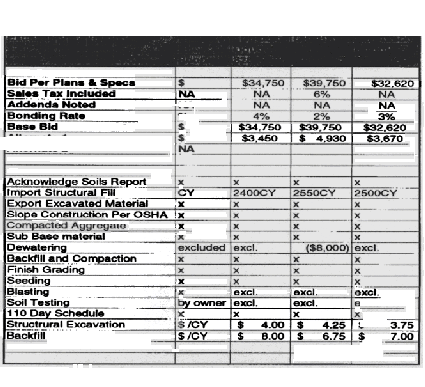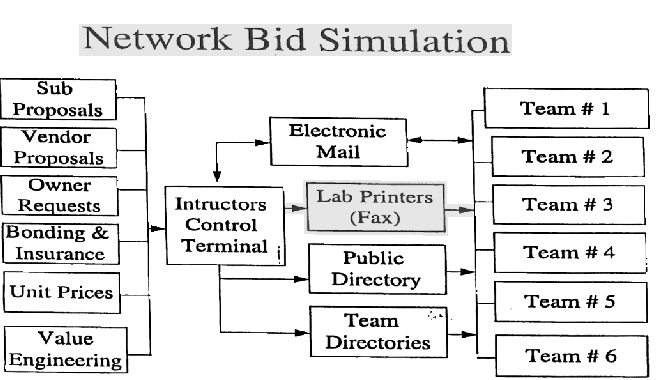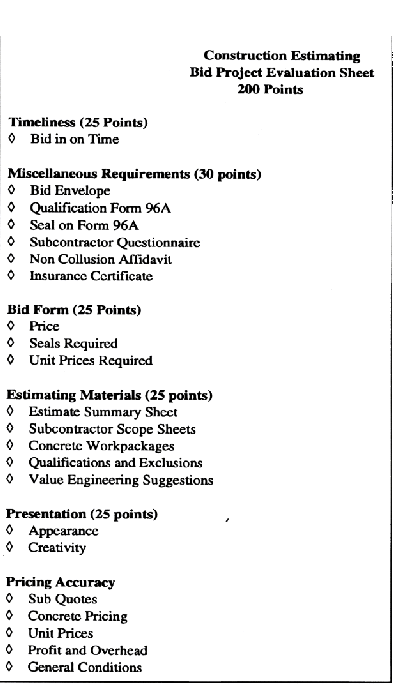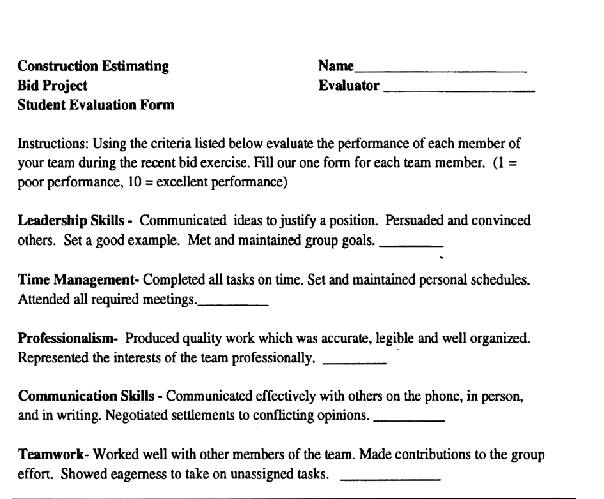|
(pressing HOME will start a new search)
|
|
Using
Computers to Simulate the Construction Bid
Stephen
P. Mead
Department
of Construction Management
East
Carolina University
Greenville,
North Carolina
|
One of the challenges facing construction educators is preparing students for the construction bid process. In today's diverse building environment, where contractor's rely heavily on specialized subcontractors and vendors, bidding has become one of the largest components of the estimating process. Unfortunately, it is difficult to simulate the time intensive pressures of the bid process in the classroom. This article discusses the how to use a networked classroom computer system to simulate the construction bid process. Keywords: Construction, Estimating, Bidding, Computers, Simulation |
Introduction
Recent
studies indicate that one of the most important competencies which are developed
in Construction education programs is estimating. One of the participants in a
recent study commented, "We need people who can contribute to the bottom
line."(Mead, Gehrig, 1994). Of course the profitability of a project is
generally a result of the accuracy of the estimating process. As a result, a
solid understanding of estimating technique is essential to the success of
future constructors.
In
the past most contractors approached estimating much like it is taught in the
class room. Each brick or stick was quantified then priced, the prices were
summarized and a profit was added to the bottom line. This system worked well
when the majority of a contractor's work was self-performed. But over the last
twenty years, contractors have moved toward "brokering" much of the
project work, and its associated liability to subcontractors. As a result,
soliciting and analyzing sub quotations has become one of the largest components
of the general contractor's estimating process.(White, G.L. 1993)
In
the past, educators have struggled with establishing an environment which
approximates what happens in a general contractors office on bid day. While
recent developments in estimating laboratories and construction simulation
centers can help facilitate the bid process, it is difficult to establish an
environment which approximates the chaotic atmosphere of a general contractor's
bid room. Fortunately. computer technology may be able to help educators
simulate the rapid fire exchange of information which occurs during the bid
process.
Today’s Bid Environment
Lets
look at what happens during a construction bid during the two hours before the
bid is due. Most contractors handle bid day with a team of estimators, project
managers, and support staff. Using the plans and specifications this team
collects all of the information needed to price the job. In today's subcontract
intensive environment, a large part of the bid is collecting and digesting
subcontractors quotes. (J. Morrisey, Personal Communication 1994)
These
quotes each contain important pieces of information. Most obvious is the
subcontractor's price. This bottom line number may contain allowances for taxes,
bonds, insurance and wage rate requirements, as well as the material and labor
costs of the work. Each quote may also contain unique information on the
subcontractors qualification and exclusions, and scheduling information on the
subcontractor's work.
During
a typical bid, the estimating team handles hundreds of sub quotes. The quotes
arrive through the mail or over the fax, and some quotes are delivered
personally to the contractor's office. Additionally, many subcontractors give
their quotes over the phone, then follow up with a written copy of the proposal
once the bid is complete.
In
this era of bid cutting and shopping, many electrical and mechanical contractors
wait until the last possible moment to phone in their quotes. This helps protect
their number from bid shopping during the bid process, but it puts additional
pressure on the estimating team in handling last minute prices. In today's
competitive marketplace it is not unusual to process five hundred quotes in the
two hours before bid time.(Engineering News Record, 1992)
Scoping: Handling Sub Quotations Efficiently
How
do organized contractors handle this chaotic process? In two ways. One, many
contractors take sub quotes, then compare each subs scope of work, pricing and
scheduling information with other subs quotes in that category of work. This
"letting the chips fall where they lie" method saves contractor's time
at the front end of the bid process, but often fails to uncover omissions or
duplications of work between subs.
Another
approach is called "scoping". Here, the estimating team reviews the
plans and specifications and develops a list of work which they feel should be
completed as part of each division of work. This list is then distributed to
each sub prior to bid time, or discussed with the sub when the quote comes in.
Generally, scopes are placed in spreadsheet
format,
with the names and numbers of the subs along the top of the sheet, while the
work items are listed in the first column.
The
scoping process forces estimators to review and understand the project at its
most detailed level. As such. this review helps contractor's eliminate scope
overlap between subs, and also helps define the contract between sub and
contractor once the bid is complete. Score sheets enable estimators and their
staff to collect and analyze information quickly, and they provide a way of
graphically comparing one subs work to another.
For
instance, if a subcontractor misses an item of work, the estimator circles the
omission on the scope sheet. Estimators call these omissions "holes."
Using another sub's detailed quote, or a price generated in - house, the
estimator then fills the hole with a "plug number". This helps
estimators analyze and compare different bids. Once all of the holes are filled
with plugs, the estimator can analyze each bid for the best complete price. In
this way, organized estimators collect and analyze qualifications, exclusions,
and pricing during the chaotic moments that lead up the bid.
Other Complications: Unit Pricing and Value Engineering
The
bid
process is further
complicated by Architects and Owners increasing requests for unit pricing and
value engineering suggestions. Over the past 10 years, owners and architects
have asked contractor's to break down their lump sum prices into more
understandable unit costs. Unit pricing helps "nail down" pricing for
change order work, and also serves as a cost comparison between bidding
contractors.(J. Morrisey, Personal Communication, 1995)
As
an example, architects often ask contractor's for unit costs on duplex
electrical outlets. In turn, the contractor asks each of his electrical subs to
provide a unit cost for duplex outlets at bid time. When the costs arrive, the
contractor adds a markup for overhead and profit to the subs unit cost, then
submits the new unit price as part of the bid. While this seems simple, it is
not unusual for an architect to ask for 20 or thirty unit costs as part of a
contractors bid. Assembling these costs in the final minutes of the bid process,
puts a lot of pressure on the estimating team.
|
|
|
Figure
1. Master Scope |
Value
engineering also complicates the bidding process. Increasingly, specifications
call for value engineering suggestions as part of the contractors bids. As a
result, estimators and their subcontractors have to assess the work for
constructability and make value engineering suggestions to the owner. These
suggestions have to be analyzed and included as part of the bid package to the
owner. (O'Brien, 1994)
Finally,
the estimating team is also responsible for administering the terms of the bid.
That is, estimators have to take care of insurance certificates, bonding
requirements, and completing the bid form and envelopes. Bid forms are often
complicated legal documents which require an estimators careful scrutiny.
The
accuracy of the estimator's work in the intense, demanding minutes before a bid
is due, often define the profitability of the project. Typically, most of these
details come together in the pressure filled hours before a bid is due. As bid
time draws near, the estimating team assembles the sub quotes, unit costs, and
value engineering suggestions into the bid package. Additionally, they complete
the bid forms, attach bonding documents and assemble qualifications and
exclusions to the bid. Faxes arrive, phones ring, scopes are compared,
negotiations are made. At the last moment, the price is given to the bid runner,
who sprints to the architect's office to deliver the bid.
Simulating
the Bid Process in the Classroom
Some
Limitations
Many
university construction programs don't have the facilities required to simulate
a realistic construction bid. Today, most contractors use state of the art phone
systems, fax machines, and computer systems to move estimating information
during the bid process. Given declining resources, most construction education
programs can't dedicate the space or the equipment required to replicate a
contractor's bid room. In most cases, it isn't practical for a department to set
up a phone or fax system which will be used solely for estimating bid projects.
Attempts
have been made to simulate the process by forming student teams, who act as
independent contractors on a specific set of plans and specifications. Using a
script prepared by the class professor, volunteers submit bids and clarify
scopes with each of the class estimating teams. (Kirk, Khattab 1993) Another
approach is to provide the estimating teams with detailed written proposals for
each subcontractor an hour prior to the bid time. The teams then analyze each of
the proposals to determine which subcontractor has a complete scope of work and
the best price.
But
both of these approaches have their limitations. In the first case,
subcontractors have an intimate knowledge of each specific project which comes
from preparing a detailed estimate of the work. As such, volunteer instructors
don't have the project knowledge required to make informed decisions on the
complexities of price and scope of work. They can't answer pertinent questions
which typically come up during the bid process like, "Will you furnish but
not install the anchor bolts listed on the plans?" From an instructors
viewpoint, organizing the volunteers and their quotations also takes a lot of
time and effort. Like most real world construction bids, things have away of
going haywire.
The
second approach. which uses written quotations, allows the estimating team to
work with detailed subcontractor proposals. Unfortunately, in real world bidding
situations, the subcontractor proposal never arrive at the same time. Quotations
arrive via the fax machine, over the telephone, via the mail, and increasingly
through electronic links. In today's competitive world of bid cutting and
shopping, it is not unusual for a contractor to receive all of their electrical
and mechanical quotes fifteen minutes prior to bid time. Moreover, written
quotations precludes using phone quotations during the bid. These
"audio" communications between contractor and subs are integral to the
modern bidding process.
A
Simulation Study
Project
Description
Over
the last two years, we have used the plans and specifications for a commercial
project with a construction cost of about $1,000,000. The project includes a
cooling tower basin and mechanical auxiliary building for a power generation
facility at a major university. This project was completed in 1992, and the
contractor has given our program the complete bid and historical costs on the
project.
At
the start of the class, each student buys a set of the plans, and the course
pack for the class. The project specifications are incorporated in the course
pack for the students use. During the estimating class, these plans and specs
are used to develop quantity surveys, specification summaries and unit pricing
for individual divisions of work. This process helps get the students familiar
with the project prior to the bid exercise.
Forming Student Teams
The
bid exercise takes about two weeks. In the first week, the students are divided
into teams of three members. Based on student performance, the instructor
designates one of these members as a chief estimator. The chief estimator is
asked to organize and schedule the bid and delegate tasks to other team members.
To encourage competition, we ask each of the teams to form a company, with a
company name and logo.
During
the first week, students attend a mock pre bid meeting, where our instructors
act as architect, engineer, and owner's representative. Before the meeting, we
ask each of the teams to review the plans and specifications and develop a list
of estimating questions on the project. At this meeting each team is given a
list of qualified subcontractors and a "bid package" which includes
the bidding documents, bonding and insurance requirements, and unit price
sheets. We also hand out a check list of items which will be used to analyze
each bid in terms of presentation, accuracy, and completeness.
During
the mock meeting, we field questions about site conditions, the soils report and
Davis/Bacon wage standards. To help develop each team's understanding of general
conditions cost, we also review the requirements for schedule, safety, and
liquidated damages.
Student Bid Development
Over
the next few days, we ask the students to develop scope sheets on each division
of subcontracted work. To refine the student's estimating skills, we ask each
team to "self perform" the concrete work required on the project. This
forces the students to research and develop quantity surveys and work packages
using prevailing wage and material costs. Additionally, each team develops a
general conditions cost estimate using the project schedule outlined at the bid
meeting.
Typically,
one team member handles the marketing side, assembling the qualification
statement and the presentation package for the bid. Another member handles the
computer input and unit price development. Finally, the chief estimator
completes the bid form and secures bonds and insurance from one of our
instructors who acts as the surety for the project. We encourage the teams to
meet all the details ofthe bid, including value engineering recommendations,
qualifications and exclusions and the appropriate notary and corporate seals
Instructor's Chores
While
this is going on, the instructor assembles subcontractor proposals for each of
the subs on the bid list. Using the historical costs from the job, we develop
about twenty five proposals - three or four in each category of work - using
computer spreadsheets. We modify the proposals by omitting scope items or
including unnecessary work or taxes. These modifications put "holes"
in each subcontractor's quote, camouflaging the best price in each category of
work. Once the spreadsheet is complete, we save each sub's quotation as an
individual file. Each file contains the subs price, unit costs, scope of work
and specific qualifications and exclusions for the project. (Insert figure 2
here)
|
|
|
Figure
2. Subcontractor Quote Sheet |
Electronic Links
Thanks
to computer technology and digital communication, we can now help prepare
students for the chaos which occurs during the bid process. At our University,
we are fortunate to have a network which ties together instructors with the
student labs, and our colleagues within the school. In turn, that network is
linked with the Internet, and of course the world's computers.
Internally,
we use the network to process communication, via E-Mail. We also use the system
to transfer information to our computer presentation centers and our student
computer labs. For instance I can transfer files from my computer to the lab via
our public exchange directory or to individual computers in the lab.
Additionally, we can send files to the lab printers which act as a simulated fax
machines on bid day.
Bid Day
Generally,
we schedule the bid for 11:30 AM on Friday, the day we have the least amount of
lab activity. Student teams assemble at the computer lab, and we begin
simulating the bid at around 8:00 AM. Here is where the fun begins.
We
start by loading several of the proposal files into the public exchange
directory. The teams have instant access to the exchange, and they pull up and
review the sub proposals we have placed there. Next, we fire off a few faxes to
the lab printers. At specified intervals, we also forward individually tailored
proposals to each of the student team via their team directories. The students
have to field the proposals, and then use the scope sheets to analyze the
information they have obtained.
At
around 9:00, things get pretty chaotic, so we send E-Mail messages from the
owner/architect which ask the teams for some specific, and previously unasked
for, breakdowns on their concrete prices. Finally, thirty minutes before the
bid, we send an instructor to the lab. He hands out an extremely attractive
price from a subcontractor who wasn't on the bid list.
Student/Instructor Interaction
During
the bid, the teams communicate with the instructor with E-Mail messages. The
instructor can use E-Mail to fire off messages like, "Did you remember to
include an allowance in your general conditions cost for de-watering?" In
turn, the students use E-Mail to send messages to specific subcontractors-via
the instructor-to clarify scope and price. This electronic dialog creates an
exciting, and sometimes agitated, communication between students and simulated
bidders. We use the phone in the laboratory as the "hot line" to the
instructor, which is only to be used in extreme emergencies.
Generally,
the students assemble their pricing using electronic spreadsheets, or with
Timberline, a construction software application. The "marketing" team
member assembles the presentation, a runner delivers the bid, someone operates
the computers, and the chief estimator manages and supervises the process.
At
11:30 sharp we hold a public opening in our school conference room. Instructors
posing as the Architect, Owner, and Engineer, stamp the bids as they arrive and
scrutinize the bids for the details. The team quotes are then read aloud, and
then we discuss what happened during the bid process.
Evaluation
We
evaluate the student teams using two components, a team grade and an individual
grade. We formulate the team grade using the evaluation checklist that is handed
out at the pre-bid meeting. This checklist outlines the criteria for timeliness,
accuracy, documentation, presentation, and organization.
We
ask the students to review and attach the completed checklist to their
proposals. After reviewing the proposals, the instructor assigns points to each
of the criteria. In turn, these points form the team grade for each proposal.
After
the bid is completed, we ask each team member to evaluate the other members of
their team for their contribution to the bid effort. This form asks students to
assess each other in terms of leadership, time management, communication skills,
teamwork, and professionalism. The students rate themselves on a scale of one to
ten in each category. The points are then totaled and averaged for each student.
This average score then becomes the individual grade for the project.
|
|
|
Figure
3. |
Other Ideas & Improvements
Like
bids in the real world, we always have a few crises. But most of our students do
an admirable job handling the rapid fire exchange of information and molding the
information into a single price. We are, however experimenting with some
improvements.
One
idea is to streamline the delivery process for the instructor. Scheduling
shareware like Timeroo allows you to attach file transfer activities to your
computer's clock. As such, you can transfer electronic proposals at specific
times during the bid. Scheduling software frees the instructor from generating
all of the bids, and leaves time for trouble shooting and student consultation.
Also,
if you adopt a standard format, advanced spreadsheet programs like Excel can
help you assemble a database of bid proposals and bid scenarios which can be
used again and again. Somewhere in the future, we would also like to incorporate
an electronic voice mail system which will help us generate quotes phone quotes
to teams in the laboratories.
Finally,
we have decided to hold the bid opening off campus this year, which should force
the student teams to deal with a remote bid runner who can only be reached by
telephone.
Conclusions
Simulating
the bid process can help students in several ways. First off, the simulated bids
enable students to experience the time intensive pressures associated with the
bid process. Students have to collect multiple bids, and analyze those disparate
bids for scope of work, price, taxes, insurance and bonding requirements, unit
pricing and value engineering. Like a contractor's bid room, this process take:
place during a compressed time frame. forcing student teams to solve problems
and make decisions under pressure.
Secondly,
the simulated bid gives students an opportunity to work with computer
technology. During the bid process, student teams work with estimating software,
electronic data interchange, and E-mail systems. As a result, students learn how
computers and digital technology can be used effectively in contractor's
offices.
Most
importantly, the simulated bid helps students understand how construction
teams work during the estimating process. This "teambuilding" effort
helps show students how work is delegated and managed by individuals acting as a
unit. Teamwork helps improve student's interpersonal skills in oral and written
communication. Additionally, the team leaders are given valuable experience
managing a group. Groups also learn important lessons about what happens to team
efforts when any part of the process fails.
|
|
|
Figure
4. |
References
Engineering
News Record, "Shop Till they Drop" Engineering News Record March 9,
1992. pp 26 -28
Kirk,
Max W. and Mostafa Khattab, "Advanced Cost Estimating and Project
Scheduling Laboratory" American Society for Professional Estimators (ASPE)
May/June 1993
Mead,
Stephen P. and Gary Gehrig, "Skills for the 21st Century: What Constructors
Need to Know." American Professional Constructor. Volume 18, Number 3.
September 1994
O"Brien,
James, J., Preconstruction Estimating. McGraw Hill Inc. New York N.Y. 1994. p319
-323
White,
Gary L.,"Estimating- It's an Art too." presentation to the Associated
General Contractors of America. Washington D. C. Ocotber 1993.
|
|
|
Figure
5. |





